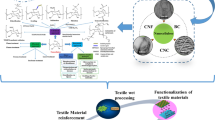Abstract
Bacterial cellulose (BC) aerogels with ultralight, low density, and low thermal conductivity are hopeful candidates for environmentally friendly heat insulating materials. However, the application of BC in packaging and building as a heat nonconductor is seriously limited by its flammable characteristics. Hence, we report a moderate approach to fabricating a flame retardant and heat-insulating composite aerogel by introducing zinc borate (ZnB) particles into BC via an ultrasound-assistant deposition process. The in situ synthesis of ZnB particles resulted in the separation of single fibers from fiber bundles in BC instead of damaging its homogeneous porous structure, improving its thermal stability by weakening the convective intensity of heat rays. The heat release capacity of the prepared composite aerogel was only 8 J g−1 k−1, exhibiting excellent flame retardancy. The probable mechanism proposed to be that the dehydration of ZnB particles lowered the surface temperature by releasing the bound water, and simultaneously produced metallic oxides (ZnO and B2O3) for retarding the spread of heat and isolating the flammable fibrils within the combustion area. Besides above scientifical meaning on understanding the thermal insulation process, because of the natural and renewable substrate and the following simple modification process, the present approach has potential applications for industrial-scale production of green and flame retardant material.








Similar content being viewed by others
Data availability
All data generated or analyzed during this study are included in this published article.
References
Anon (2004) Flame retardants: European union risk assessments update. Plastics Addit Compd 6:26–29
Bober P, Liu J, Mikkonen K, Ihalainen P, Pesonen M, Plumed-Ferrer C, Wright AV, Lindfors T, Xu CL, Latonen RM (2014) Biocomposites of nanofibrillated cellulose, polypyrrole, and silver nanoparticles with electroconductive and antimicrobial properties. Biomacromol 15(10):3655–3663
Cai HL, Sharma SH, Liu WY, Mu W, Liu W, Zhang XD, Deng YL (2014) Aerogel microspheres from natural cellulose nanofibrils and their application as cell culture scaffold. Biomacromol 15(7):2540–2547
Chen WS, Yu HP, Li Q, Liu YX, Li J (2011) Ultralight and highly flexible aerogels with long cellulose I nanofibers. Soft Matter 7(21):10360–10368
Chen HB, Chiou BS, Wang YZ, Schiraldi DA (2013) Biodegradable pectin/clay aerogels. ACS Appl Mater Interfaces 5(5):1715–1721
Costes L, Laoutid F, Brohez S, Dubois P (2017) Bio-based flame retardants: when nature meets fire protection. Mater Sci Eng R Rep 117:1–25
Fleury B, Abraham E, De Lacruz J, Chandrasekar V, Senyuk B, Liu QK, Cherpak V, Park S (2020) Aerogel from sustainably grown bacterial cellulose pellicle as thermally insulative film for building envelope. ACS Appl Mater Interfaces 12(30):34115–34121
French AD (2014) Idealized powder diffraction patterns for cellulose polymorphs. Cellulose 21:885–896. https://doi.org/10.1007/s10570-013-0030-4
Giesbers M, Marcelis ATM, Zuilhof H (2013) Simulation of XPS C1s spectra of organic monolayers by quantum chemical methods. Langmuir 29(15):4782–4788
Gonen M, Balkose D, Gupta RB, Ulku S (2009) Supercritical carbon dioxide drying of methanol-zinc borate mixtures. Ind Eng Chem Res 48:6869–6876
Hale RC, La Guardia MJ, Harvey E, Gaylor MO, Mainor TM (2006) Brominated flame retardant concentrations and trends in abiotic media. Chemosphere 64:181–186
Han YY, Zhang XX, Wu XD, Lu CH (2015) Flame retardant, heat insulating cellulose aerogels from waste cotton fabrics by in situ formation of magnesium hydroxide nanoparticles in cellulose gel nanostructures. ACS Sustain Chem Eng 3(8):1853–1859
He CL, Huang JY, Li SH, Meng K, Zhang LY, Chen Z, Lai YK (2017) Mechanically resistant and sustainable cellulose-based composite aerogels with excellent flame retardant, sound-absorption, and superantiwetting ability for advanced engineering materials. ACS Sustain Chem Eng 6(1):927–936
He C, Huang J, Li S, Meng K, Zhang L, Chen Z, Lai Y (2018) Mechanically resistant and sustainable cellulose-based composite aerogels with excellent flame retardant, sound-absorption, and superantiwetting ability for advanced engineering materials. ACS Sustain Chem Eng 6:927–936
Jaramillo-Paez CA, Navio JA, Hidalgo MC, Macias M (2018) ZnO and Pt-ZnO photocatalysts: characterization and photocatalytic activity assessing by means of three substrates. Catal Today 313:12–19
Jones RJ, Srubar III WV (2022) Biomineralization of symbiotic cultures of bacteria and yeast (SCOBY) cellulose aerogels. Adv Eng Mater 24(12):2200681
Joni IM, Nishiwaki T, Okuyama K, Isoi S, Kuribayashi R (2010) Enhancement of the thermal stability and mechanical properties of a PMMA/aluminum trihydroxide composite synthesized via bead milling. Powder Technol 204(1):145–153
Khalili P, Liu XL, Tshai KY, Rudd C, Yi XS, Kong I (2019) Development of fire retardancy of natural fiber composite encouraged by a synergy between zinc borate and ammonium polyphosphate. Compos B Eng 159:165–172
Köklükaya O, Carosio F, Wågberg L (2017) Superior flame-resistant cellulose nanofibril aerogels modified with hybrid layer-by-layer coatings. ACS Appl Mater Interfaces 9:29082–29092
Li Y, Wang B, Sui X, Xu H, Zhang L, Zhong Y, Mao Z (2017) Facile synthesis of microfibrillated cellulose/organosilicon/poly-dopamine composite sponges with flame retardant properties. Cellulose 24:3815–3823
Li YM, Deng C, Shi XH, Xu BR, Chen H, Wang YZ (2019) Simultaneously improved flame retardance and ceramifiable properties of polymer-based composites via the formed crystalline phase at high temperature. ACS Appl Mater Interfaces 11(7):7459–7471
Liu Y, Wang Q (2009) The investigation on the flame retardancy mechanism of nitrogen flame retardant melamine cyanurate in polyamide 6. J Polym Res 16(5):583–589
Liu T, Liang FW, Chen S, Zhang P, Qian K, Xu Y, Guo WW (2022) Aramid reinforced polyimide aerogel composites with high-mechanical strength for thermal insulation material. Polym Adv Technol 2023:1–8
Lowe SE, Zhong YL (2016) Challenges of industrial-scale graphene oxide production. In: Dimiev AM, Eigler S (eds) Graphene oxide: fundamentals and applications. Wiley, West Sussex, pp 410–431
Lv QT, Yang JF, Sun X, Tang H, Wang LX (2022) Preparation of highly efficient thermal insulating halloysite nanotubes/polyvinyl alcohol composite aerogel based on a simple freeze-drying strategy. Polym Compos 2022:1–10
Nakashima H (1994) Time Course of Effects of Tetraethoxysilane (TEOS) on the Kidney and Blood Silicon Concentration in Mice. Arch Toxicol 69:59–64
Nakashima H, Omae K, Sakai T, Yamazaki K, Sakurai H (1994) Acute and subchronic inhalation toxicity of tetraethoxysilane (TEOS) in mice. Arch Toxicol 68:277–283
Nelson ML, O’Connor RT (1964) Relation of certain infrared bands to cellulose crystallinity and crystal latticed type. Part I. Spectra of lattice types I, II, III and of amorphous cellulose. J Appl Polym Sci 8:1325–1341
Nguyen TTV, Tri N, Tran BA, Duy TD, Nguyen ST, Nguyen TA, Phan AN, Thanh PM, Huynh HK (2021) Synthesis, characteristics, oil adsorption, and thermal insulation performance of cellulosic aerogel derived from water hyacinth. ACS Omega 6:26130–26139
Pan Y, Liu LX, Wang X, Song L, Hu Y (2018) Hypophosphorous acid cross-linked layer-by-layer assembly of green polyelectrolytes on polyester-cotton blend fabrics for durable flame-retardant treatment. Carbohydr Polym 201:1–8
Qian G, Wu B, Qin Z, Li X, Zheng ZZ, Xia R, Qian JS (2022) Enhanced thermal conductivity via in situ constructed CNT aerogel structure in composites. Adv Mater Interfaces 9(12):2102098
Shen KK, Kochesfahani S, Jouffret F (2008) Zinc borates as multifunctional polymer additives. Polym Adv Technol 19:469–474
Viggiano RP, Williams JC, Schiraldi DA, Meador MAB (2017) Effect of bulky substituents in the polymer backbone on the properties of polyimide aerogels. ACS Appl Mater 9(9):8287–8296
Wicklein B, Kocjan A, Salazar-Alvarez G, Carosio F, Camino G, Antonietti M, Bergstrom L (2015) Thermally insulating and fire-retardant lightweight anisotropic foams based on nanocellulose and graphene oxide. Nat Nanotechnol 10(3):277–283
Xu CL, Wei ZH, Gao HJ, Bai YJ, Liu HL, Yang HL, Lai YK, Yang L (2017) Bioinspired mechano-sensitive macroporous ceramic sponge for logical drug and cell delivery. Adv Sci 4(6):1600410
Yan MY, Pan YL, Cheng XD, Zhang ZX, Deng YR, Lun ZY, Gong LL, Gao MY, Zhang HP (2021) “Robust−Soft” anisotropic nanofibrillated cellulose aerogels with superior mechanical, flame-retardant, and thermal insulating properties. ACS Appl Mater Interfaces 13:27458–27470
Yu RM, Shi YZ, Yang DZ, Liu YX, Qu J, Yu ZZ (2017) Graphene oxide/chitosan aerogel microspheres with honeycomb-cobweb and radially oriented microchannel structures for broad-spectrum and rapid adsorption of water contaminants. ACS Appl Mater Interfaces 9(26):21809–21819
Yuan B, Zhang J, Mi Q, Yu J, Song R, Zhang J (2017) Transparent cellulose−silica composite aerogels with excellent flame retardancy via an in situ sol−gel process. ACS Sustain Chem Eng 5:11117–11123
Zhang J, Cao YW, Feng JC, Wu PY (2012) Graphene-oxide-sheet-induced gelation of cellulose and promoted mechanical properties of composite aerogels. J Phys Chem C 116:8063–8068
Zhao CQ, Chen F, Dong SS, Liu XY, Qi HM, Deng SF (2022) Silicon-containing polyarylacetylene aerogel with heat resistance and ablative property for high-temperature insulation. J Appl Polym Sci 135(15):e52385
Zhu LT, Zong L, Wu XC, Li MJ, Wang HS, You J, Li CX (2018) Shapeable fibrous aerogels of metal-organic-frameworks templated with nanocellulose for rapid and Large-Capacity Adsorption. ACS Nano 12(5):4462–4468
Funding
This work was supported by the grants from the Guangxi Key Laboratory of Chemistry Engineering of Forest Products (GXFK2306) and National Natural Science Foundation of China (No. 31770622). We also thank Diana Hembree for the valuable suggestion and edition during the preparation of this paper.
Author information
Authors and Affiliations
Contributions
ZXW: Investigation, Data curation, Formal analysis, Writing. YYE: Writing—review & editing. JL: Data curation, Formal analysis. TTD: Writing—review & editing. KW: Conceptualization, Project administration, Writing—review & editing, Funding acquisition. XY: Writing—review & editing. JXJ: Formal analysis, Supervision. MW: Writing—review & editing. SGY: Writing—review & editing
Corresponding authors
Ethics declarations
Conflict of interest
The authors declare no competing interests.
Ethical approval and consent to participate
Not applicable.
Consent for publication
All authors have read and agreed to the published version of the manuscript.
Additional information
Publisher's Note
Springer Nature remains neutral with regard to jurisdictional claims in published maps and institutional affiliations.
Supplementary Information
Below is the link to the electronic supplementary material.
Rights and permissions
Springer Nature or its licensor (e.g. a society or other partner) holds exclusive rights to this article under a publishing agreement with the author(s) or other rightsholder(s); author self-archiving of the accepted manuscript version of this article is solely governed by the terms of such publishing agreement and applicable law.
About this article
Cite this article
Wang, Z., E, Y., Li, J. et al. Sustainable bacterial cellulose-based composite aerogels with excellent flame retardant and heat insulation. Cellulose 30, 9563–9574 (2023). https://doi.org/10.1007/s10570-023-05461-9
Received:
Accepted:
Published:
Issue Date:
DOI: https://doi.org/10.1007/s10570-023-05461-9




